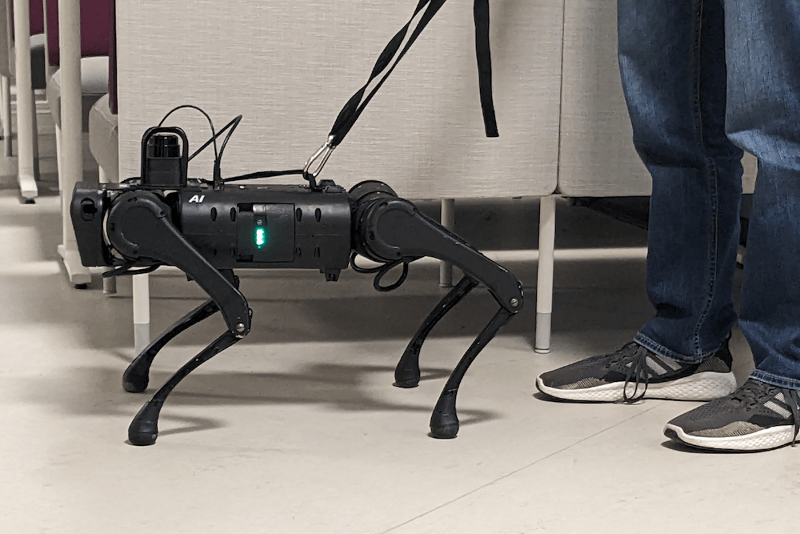Guide dogs have long been a valuable companion for the visually impaired, but the process of raising and training them is costly and time-consuming. However, recent advancements in robotics have opened up a new possibility - outsourcing the job to dog-like quadruped robots. These robots offer a cost-effective and efficient alternative to traditional guide dogs, with the potential to revolutionize the lives of the visually impaired. In this article, we will explore how these robots are being developed and the benefits they bring to the visually impaired community.
The Cost and Challenges of Traditional Guide Dogs
Exploring the financial and logistical challenges of breeding, raising, and training traditional guide dogs.
Traditional guide dogs play a crucial role in assisting the visually impaired, but the process of breeding, raising, and training them comes with significant costs. According to Guide Dogs of America, it can cost up to $48,000 to breed, raise, and train a single guide dog. This includes expenses such as food, veterinary care, and specialized training.
Moreover, the training period for a guide dog can take several months, requiring dedicated resources and expertise. The high cost and time commitment associated with traditional guide dogs make it challenging for many visually impaired individuals to access these valuable companions.
The Rise of Quadruped Robots
Exploring the emergence of quadruped robots as an alternative to traditional guide dogs.
Advancements in robotics have paved the way for the development of quadruped robots that can serve as guide dogs for the visually impaired. These robots are equipped with sensors that enable functions such as obstacle detection, trajectory planning, and navigation, making them well-suited for guiding blind users.
Unlike traditional guide dogs, quadruped robots can be preprogrammed and do not require food, water, or exercise. They offer a cost-effective and efficient solution for the visually impaired, eliminating the need for extensive breeding and training processes.
Training Quadruped Robots as Guide Dogs
Exploring the process of training quadruped robots to assist the visually impaired.
To enable quadruped robots to function as guide dogs, researchers have developed innovative training methods. By attaching an ordinary dog leash to the robot and using reinforcement learning techniques, the robot can be trained to respond to leash tugs by turning left or right.
In a recent demonstration, the adapted quadruped robot successfully guided a person along a hallway, responding to directional leash tugs at intersections. However, further advancements are needed to enhance the robot's capabilities, such as adding a natural language interface and incorporating intelligent disobedience to ensure user safety.
Benefits and Potential Applications
Examining the benefits and potential applications of using quadruped robots as guide dogs.
The use of quadruped robots as guide dogs offers several advantages. These robots can be deployed in various environments without the need for extensive training or specific living conditions. They can navigate challenging locations such as shopping malls and airports, providing temporary assistance to the visually impaired.
Furthermore, the cost-effectiveness of quadruped robots makes them accessible to a wider range of individuals. The potential applications extend beyond personal use, with the possibility of integrating these robots into public spaces to enhance accessibility for the visually impaired community.
Conclusion
In conclusion, the development of quadruped robots as guide dogs holds immense potential for the visually impaired community. These robots offer a cost-effective and efficient alternative to traditional guide dogs, eliminating the financial and logistical challenges associated with breeding and training. With their advanced sensors and preprogrammed capabilities, quadruped robots can navigate various environments and provide temporary assistance in challenging locations. The integration of natural language interfaces and intelligent disobedience further enhances their functionality.
By harnessing the power of robotics, we can revolutionize the lives of the visually impaired, providing them with greater independence and accessibility. The benefits of quadruped robots extend beyond personal use, with the potential for widespread integration in public spaces. As technology continues to advance, we can look forward to a future where quadruped robots play a vital role in enhancing the lives of the visually impaired.
FQA
Are quadruped robots a complete replacement for traditional guide dogs?
Quadruped robots offer a promising alternative to traditional guide dogs, but they are not a complete replacement. While robots can provide valuable assistance in navigation and obstacle detection, traditional guide dogs offer additional benefits such as companionship and emotional support.
Can quadruped robots be customized to individual needs?
Yes, quadruped robots can be customized to some extent. Through reinforcement learning and programming, the robots can be trained to respond to specific commands and adapt to individual user preferences. However, further advancements are needed to enhance their customization capabilities.
What are the limitations of quadruped robots as guide dogs?
Quadruped robots have certain limitations compared to traditional guide dogs. They may not possess the same level of intuition and ability to handle complex situations. Additionally, the lack of physical presence and emotional connection that guide dogs provide can be a drawback for some individuals.
How soon can we expect quadruped robots to be widely available?
While quadruped robots show great promise, there is still ongoing research and development to improve their functionality and address potential challenges. It may take several years before they become widely available for use by the visually impaired.

